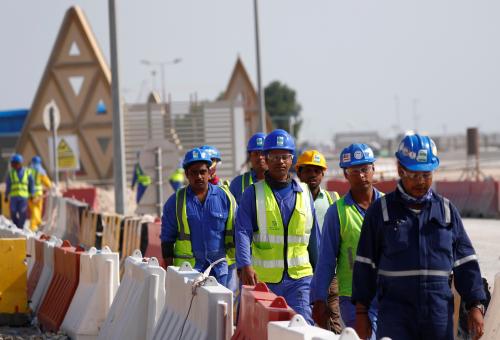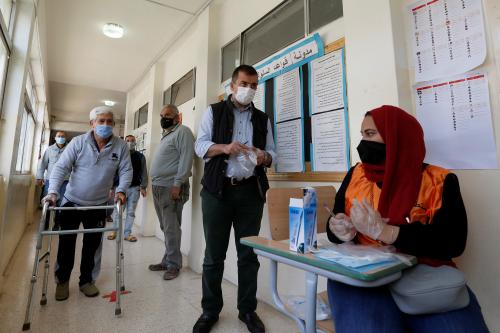Content from the Brookings Doha Center is now archived. In September 2021, after 14 years of impactful partnership, Brookings and the Brookings Doha Center announced that they were ending their affiliation. The Brookings Doha Center is now the Middle East Council on Global Affairs, a separate public policy institution based in Qatar.
Bihar, the Indian state where Buddha attained enlightenment, where the civilization’s greatest empires sprang from, and which saw the world’s first residential university, yesterday delivered a sharp blow to the ruling BJP. The election loss in the heartland state came after a period of intense debate over tolerance and India’s national identity. Attacks on minorities and rationalists, combined with communalist rhetoric and religion-based policies aggravated India’s long simmering ‘culture-wars’.
While India is not new to communal tensions, these had failed to register with much of the Western public which maintained an impression colored by values of tolerance, pluralism and non-violence. This image was partly a legacy of the ideals of the independence movement vocalized by Gandhi, and Nehru’s foreign policy. The West’s ‘discovery’ of Indian spirituality in the 1960s and exposure to philosophical and yogic traditions accentuated this perception. For decades, the average Westerner thought of India as ‘poor but good’, as opposed to the more negative views held about China, Pakistan, the Middle East, Russia and others. Violence, like the 1984 anti-Sikh violence, did not seep into mainstream consciousness.
India’s global rise, however, has brought with it more of a spotlight. When the Gujarat riots occurred in 2003, many Westerners saw for the first time that India also had its share of extremists.
In some non-Western regions of the world, India’s image is slower to change. In the Middle East for instance – a region where Hindu-Muslim tensions would be expected to damage India’s image most -impressions have remained largely the same since the days of the Non-Aligned Movement. However, this too may now begin to alter. Ironically, what Modi has been best at – directing attention to India’s star on the world stage – has led to greater coverage of all dimensions of the country. Op-eds are being written highlighting the lynching of Muslims, outside of the usual Kashmir reporting.
Modi still has some buffer room, however. This is because most people in the Middle East and elsewhere in the Global South still likely judge India largely through the prism of foreign affairs. Aside from Kashmir and altercations with Pakistan, New Delhi is seen as a generally benign influence on the world. It’s just like how most people do not judge the US based on their view of American society but more on hard-edged foreign policy actions. Middle Eastern impressions of India are anchored by the 7 million plus Indians working in the region who have a reputation for peacefulness and tolerance.
The underpinnings of this ‘image buffer’ are also witnessed in the multiple layers of irony found in the current tolerance debate. India’s ‘culture-wars’ often pit the left-leaning intelligentsia against right-religious political and communal leaders. This time the ducks are all aligned, providing a big, contiguous target for intellectuals’ indignation – a Prime Minister with communalist baggage, a BJP Government holding a large majority in parliament implementing religion-based policies, BJP politicians making incendiary comments, all the way down to grassroots activists running amok.
The strength of the opposing voices, and their existence in such abundance is, however, evidence itself of India’s tolerance and pluralism. Indian civil society and intellectuals have an impact on public discourse which would be the envy of their Western counterparts. If American intellectuals and artists returned their awards in protest at Government action (let alone inaction) it would either receive little coverage or they would be painted without exception as out-of-touch ‘ivory tower elites’ by the elite-owned mainstream media. In India, however, the long-time honoring of educational achievement means their protestations are always worthy of attention.
Another irony is that the political ideologues accused of intolerance see themselves as defenders of Hinduism, and to a lesser extent Buddhism, Jainism and other philosophies – some of the earliest roots of Indian culture’s tolerance. Hinduism is notable for its acceptance of multiple pathways to truth. Ancient India stood out from its civilizational contemporaries with lively, peaceful debates between Brahmans who worshipped gods, Buddhist philosophers and, atheistic and rationalist sects like Ajivikas.
During the Mughal period, Muslim Emperor Akbar encouraged religious freedom and supported intercommunity dialogue involving people of various faiths and atheists. Early interactions with Islam, Christianity and Judaism furthered the pluralistic character of India. Similar cultural trends existed throughout the subcontinent. In Sri Lanka, a colonial era British missionary once described Buddhist monks’ friendly accommodation of the missionaries’ evangelism as “the pernicious vice of tolerance”. Similarly the reverence for the cow stems from one of Hinduism’s core values, which heavily influenced and was influenced by Buddhism – compassion for all living beings and the understanding that all life is interconnected.
PM Modi is in a particularly tricky bind, as reflected by his silence. If he disavows the comments of BJP firebrands, he risks being thought of as a ‘sellout’ by the Rashtriya Swayamsevak Sangh (RSS) supporters he requires for grassroots activism during elections. Alternatively, if he stands behind the outspoken BJP members he risks further division leading to instability, losing the Muslim vote completely, and weakening India’s soft power abroad.
Modi’s approach thus far has been to try to shift attention towards his economic platform, the reason most people, regardless of religion, voted for him. This didn’t work in Bihar, which was seen as a referendum on the PM’s leadership. Political opponents attributed the loss to the BJP’s communalist image. If true, this is a testament to the strength of the value of tolerance amongst residents of what, in modern times, has been regarded as India’s poorest, most ‘backward’ state (very different to the direction taken by the Republican Base). Perhaps the daily challenges of poverty have not completely overshadowed the ideals preached millennia ago by Buddha and Emperor Ashoka who ruled India’s greatest empire from Bihar. More likely it was a combination of this and the slow pace of poverty alleviation.
A final irony is that the scrutiny India faces over intolerance is in part because the country had set such a high bar for itself long ago in comparison to other postcolonial nations. Luckily for Modi Ji the tide of opinion moves slower overseas and the coffers of goodwill toward India have been left full thanks to decades of largely peaceful foreign policy, and millennia of cultural tolerance and pluralism.
This article originally appeared in
The Huffington Post
.
The Brookings Institution is committed to quality, independence, and impact.
We are supported by a diverse array of funders. In line with our values and policies, each Brookings publication represents the sole views of its author(s).



Commentary
Op-edIndian Tolerance: The View from Outside
November 9, 2015